![]()
![]()

The first destroyer Hull (DD-7) was laid down by Harlan & Holligsworth of Wilmington, Delaware 22 February 1899; launched 21 June 1902; sponsored by Miss Mabel Hull, a descendant of Commodore Hull; and commissioned 20 May 1903, with Lieutenant S. S. Robinson commanding.
During her first 2 years of service, Hull engaged in patrol and training maneuvers off Newport and in Chesapeake Bay. After a cruise to the Caribbean January-April 1905, she returned to League Island, Pennsylvania, where she was decommissioned 30 September 1905.
Hull was recommissioned 14 November 1906 at Philadelphia, and took part in winter exercises with fleet units in Cuban waters. After operations off Newport, the ship returned to Norfolk in October 1907 to prepare for the voyage of the Great White Fleet.
In 1907-1908, Hull, as part of the Torpedo Flotilla, sailed as an escort vessel, accompanying the Atlantic Fleet on a practice cruise to the Pacific. They put to sea from Hampton Roads 2 December 1907, under Lieutenant Frank McCommon, exchanging courtesies at various Mexican and South American ports on the voyage around South America with the great battleships. After target Practice in Magdalena Bay, the Flotilla arrived at San Diego 28 April 1908 and then proceeded to San Francisco, arriving 6 May 1908, in time for the review of the combined Atlantic and Pacific Fleets by the Secretary of the Navy.
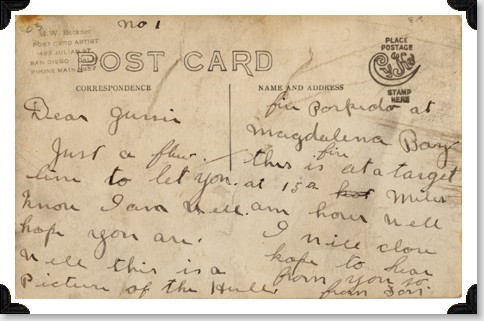
Dear Junie
Just a few line to let you know I am well. Hope you are.
Well this a picture of the Hull.
Fire torpedo at Magdalena Bay.
This is fire at a target at 15 miles an hour.
I will close hope to hear from you to.
from Jan
This is what I think the postcard has on the back.
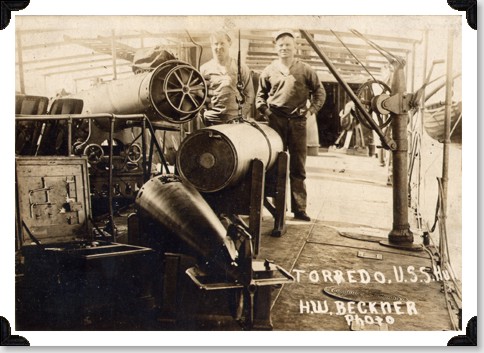
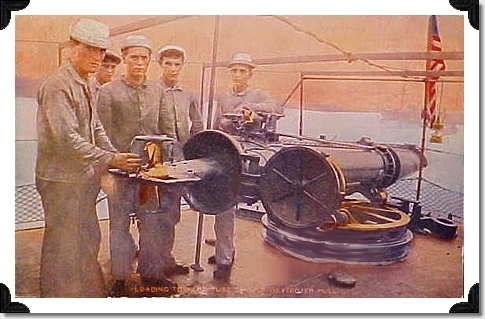
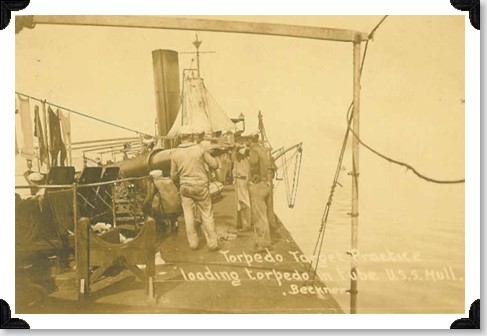
Above postcard from the collection of
Jim Myerson
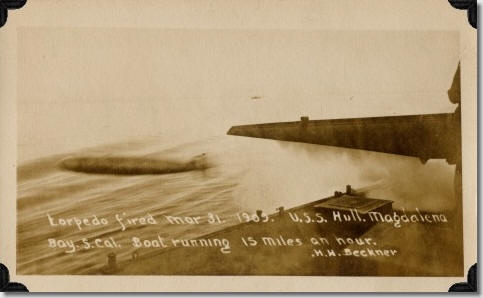
Magdalena Bay is located about 800 miles south of San Diego on the Pacific Ocean side of Baja California. This bay is larger than San Francisco Bay.
Post cards from collection of Dave Vrooman.
Hull was detached on the west coast, as the Great White Fleet continued on its cruise, showing the flag around the world. The destroyer remained in the vicinity of San Francisco until departing 24 August 1908 for a cruise to the South Pacific. She took part in various exercises in Hawaiian and Samoan waters before returning to San Diego in November.
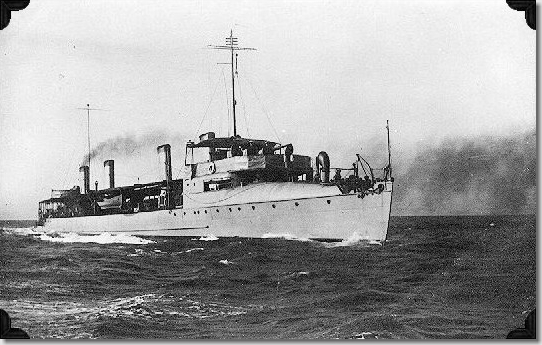
Above picture from the collection of
Paul A. Roales
Hull spent the years before World War I on patrol and training exercises off the California coast. She decommissioned 30 October 1912 and joined the Reserve Torpedo Division at Mare Island, with which she made occasional training cruises to California ports. It was during this time the she served as a training vessel for the California Naval Militia.
When America entered the WW I in April 1917 Hull was being refitted at Mare Island. She sailed with other destroyers for the Canal Zone 25 April 1917 and for the next 3 months was engaged in defensive patrol off the western approaches to that vital waterway. She sailed to Norfolk 26 July for escort and patrol duty along the East Coast. In the months that followed Hull escorted ships to Bermuda and engaged in training maneuvers with other ships of the fleet as well. Hull was transferred to Hampton Roads, and patrolled the east coast through out the war.
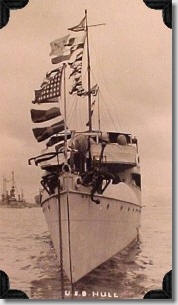
In June 1918, she broke up an attack by German submarine U-151 on a merchant ship. Hull while preforming her patrol duties often rescued sailors from sinking ships. She continued this vital function at sea until the end of WW I.
Hull arrived in Philadelphia 29 January 1919, was decommissioned 7 July 1919, and stricken 15 September 1919.
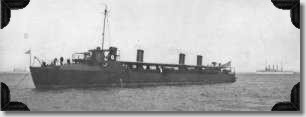
As Built2
Displacement: 408 Tons; Length: 248' 8" (oa); Beam: 24' 6" ;
Draft: 6' (Max)
Battery: 2 - 3"/50 rapid fire guns, 6 - 6 pounder semi-automatic guns, 2 - 18"
Whitehead Torpedo Tubes3
Machinery: 7,200 IHP; 2 Vertical, Inverted, Triple Expansion Engines; Twin
Screws; Bunker Capacity: 143 tons
Speed: 29 Knots
Complement: 3 officers, 72 men
Fate4
Hull was sold 3 January 1920 to Joseph G. Hitner of Philadelphia and broken up for scrap.
![]()
1 - These are not Torpedo Boats, but are instead
classed as Destroyers.
2 - In some accounts these numbers may vary.
3 - There were obvious problems with the first torpedoes (the
spar torpedo). First, the attacker had to get very close to the enemy to use the
device. Second, the resulting blast could be as lethal to the user as to its
intended victim. A major advance came within a few years in the development of
the self-propelled torpedo. By 1870, Englishman Robert Whitehead had built a
weapon that could travel several hundred yards at a speed of 8 knots.
4 - Some accounts report Hull was Sold 5 January 1921.